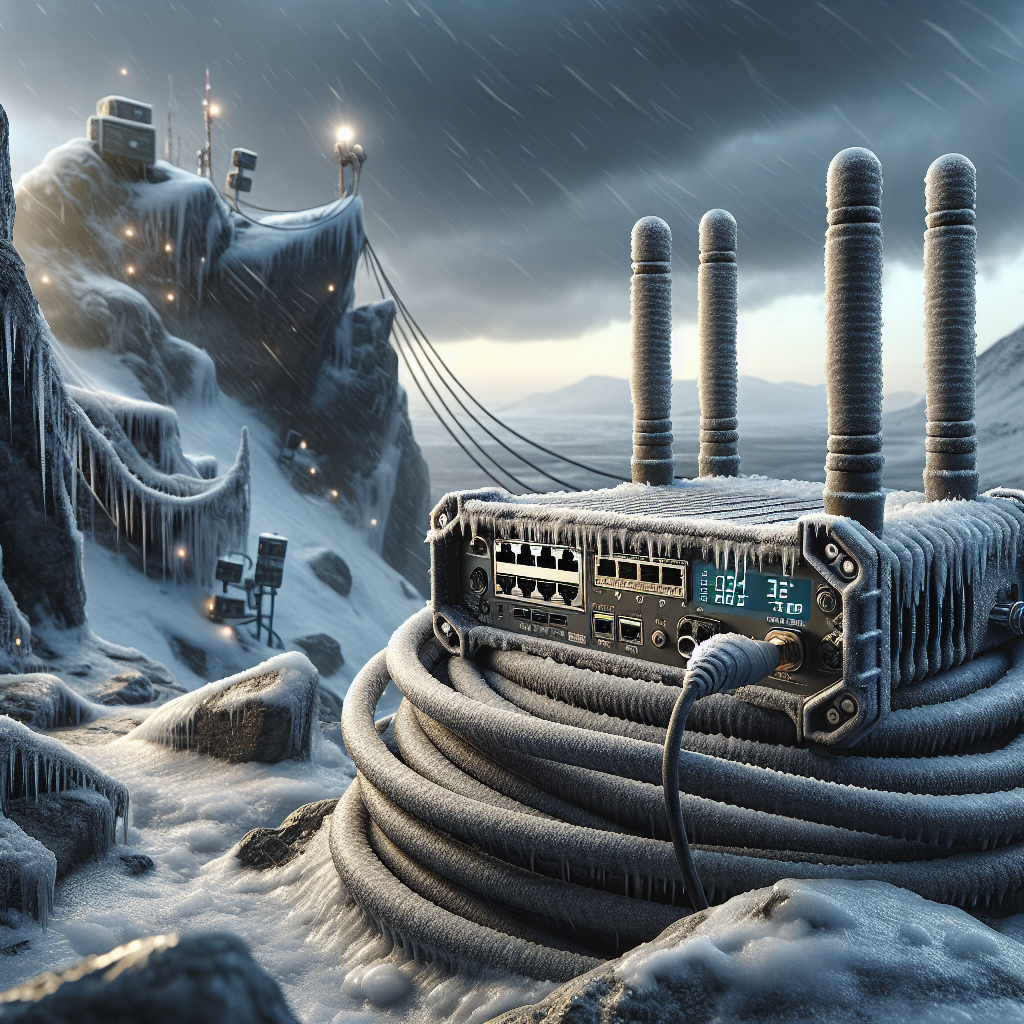Ruggedized Connectivity Solutions for Harsh Environments
September 12, 2024 | by Jerry Rodriguez

In today’s rapidly evolving technological landscape, the demand for robust and reliable connectivity solutions in harsh environments is more pressing than ever. From industrial settings to military operations, the need for ruggedized connectivity solutions that can withstand extreme conditions has become increasingly vital. Ruggedized connectivity solutions are designed to ensure uninterrupted communication and data transfer in environments where traditional equipment would falter. These solutions are built to withstand extreme temperatures, moisture, vibrations, and shocks, providing a reliable lifeline in the toughest of conditions. In this article, we will explore the importance of ruggedized connectivity solutions and how they are shaping the future of communication in harsh environments.
Understanding Ruggedized Connectivity Solutions
Ruggedized connectivity solutions refer to specialized technologies and devices designed to withstand extreme environmental conditions without compromising connectivity. These solutions are engineered to ensure reliable data transmission and communication in harsh and challenging settings where standard connectivity options may fail.
-
Definition of ruggedized connectivity solutions:
Ruggedized connectivity solutions encompass a range of components and systems that are built to be durable, robust, and resistant to various environmental stressors such as temperature fluctuations, moisture, dust, vibrations, and impact. These solutions are commonly used in industries like military, aerospace, oil and gas, manufacturing, and outdoor telecommunications where standard connectivity equipment would be prone to failure. -
Importance of ruggedized connectivity in harsh environments:
The significance of ruggedized connectivity solutions lies in their ability to maintain seamless communication and data exchange in environments where traditional systems would falter. Whether it’s in remote outdoor locations, extreme temperatures, high vibration settings, or areas with high levels of moisture and dust, ruggedized connectivity ensures uninterrupted operations critical for mission-critical applications, safety, and productivity.
Components of Ruggedized Connectivity Solutions
Cables and Connectors
mponents of Ruggedized Connectivity Solutions
In ruggedized connectivity solutions designed for harsh environments, the choice of cables and connectors plays a critical role in ensuring reliable and durable performance in challenging conditions. Here are the key aspects related to cables and connectors in such solutions:
-
Types of cables and connectors used in ruggedized solutions
-
Fiber Optic Cables: Fiber optic cables are commonly used in ruggedized connectivity solutions due to their immunity to electromagnetic interference, high data transfer speeds, and reliability in extreme temperatures.
-
Armored Cables: Armored cables feature protective layers that shield them from physical damage, such as crushing, impact, or abrasion, making them ideal for harsh industrial environments.
-
Waterproof Connectors: Waterproof connectors are essential for applications in wet or damp environments, providing a secure and reliable connection even in the presence of moisture or liquids.
-
Features that make them suitable for harsh environments
-
Durability: Cables and connectors in ruggedized solutions are designed to withstand rough handling, extreme temperatures, and exposure to dust, dirt, or chemicals without compromising performance.
-
Vibration Resistance: These cables and connectors are engineered to absorb and dampen vibrations, ensuring that the connection remains stable and reliable even in environments with significant mechanical shocks.
-
Corrosion Resistance: To prevent degradation over time, ruggedized cables and connectors often feature corrosion-resistant materials or coatings that protect them from the effects of moisture, salt spray, or corrosive substances present in harsh environments.
Protective Casings and Enclosures
In the realm of ruggedized connectivity solutions, the design and construction of protective casings and enclosures play a critical role in safeguarding sensitive electronic components from the harsh realities of challenging environments. These protective elements act as the first line of defense against a multitude of external factors that could potentially compromise the functionality and longevity of the equipment they house.
Materials used for protective casings
When it comes to selecting materials for protective casings in harsh environments, durability and resilience are paramount considerations. Commonly employed materials include:
-
Stainless Steel: Known for its corrosion resistance and robustness, stainless steel is a popular choice for protective casings in environments exposed to moisture and varying temperatures.
-
Aluminum: Lightweight yet strong, aluminum offers a good balance of strength and malleability, making it suitable for applications where weight is a concern without sacrificing durability.
-
Polycarbonate: This thermoplastic material is valued for its impact resistance and transparency, making it ideal for applications where visibility of internal components is necessary alongside protection.
-
Rubberized Coatings: Adding a layer of rubberized coating to casings can enhance shock absorption and provide a non-slip surface, particularly advantageous in environments prone to vibrations or rough handling.
Impact of environmental factors on enclosures
The harsh environments in which ruggedized connectivity solutions are often deployed can subject protective enclosures to a wide array of challenges, including:
-
Temperature Extremes: Fluctuations in temperature can lead to expansion and contraction of materials, potentially causing structural weaknesses or compromising seals that protect against moisture and contaminants.
-
Moisture and Humidity: Exposure to moisture can result in corrosion of metal components, short circuits, or mold growth. Proper sealing and ventilation mechanisms are crucial to prevent moisture ingress while allowing for adequate airflow.
-
Dust and Particulate Matter: Dust and debris can infiltrate enclosures, leading to clogging of ventilation pathways, overheating of internal components, and interference with electrical connections. Filters and ingress protection ratings are essential to mitigate these risks.
-
Mechanical Shock and Vibration: Equipment in harsh environments may be subjected to mechanical shock and vibration, which can cause dislodgment of components, solder joint fractures, or misalignment of sensitive elements. Shock-absorbing mounts and secure fastenings are essential to minimize these effects.
In conclusion, the selection of appropriate materials for protective casings and enclosures, along with careful consideration of environmental factors, is crucial in ensuring the reliability and longevity of ruggedized connectivity solutions in harsh operating conditions.
Challenges in Harsh Environments
Temperature Extremes
Challenges in Harsh Environments
In harsh environments, temperature extremes pose significant challenges for connectivity solutions. Extreme heat or cold can impact the performance and reliability of these systems, leading to potential failures and downtime. It is crucial to understand the effects of temperature on connectivity solutions and implement strategies to mitigate these challenges effectively.
- Effects of temperature on connectivity solutions:
- High temperatures can cause overheating of components, leading to degradation of materials and reduced lifespan of connectors and cables.
- Low temperatures can make materials brittle, increasing the risk of breakage and signal loss.
-
Temperature fluctuations can also cause condensation inside connectors, resulting in corrosion and signal interference.
-
Solutions to mitigate temperature-related challenges:
- Using ruggedized materials that can withstand a wide range of temperatures without degradation.
- Implementing thermal management techniques such as heat sinks or insulation to regulate temperature within the connectivity system.
- Employing seals and gaskets to prevent moisture ingress and protect against corrosion in extreme conditions.
- Conducting regular maintenance and inspections to identify and address temperature-related issues proactively.
Moisture and Humidity
Moisture and humidity present significant challenges for connectivity solutions in harsh environments due to the risks associated with exposure. Water ingress can lead to corrosion, short circuits, and overall performance degradation of electronic components. In environments with high moisture levels, traditional connectivity solutions are prone to failure, making it essential to implement robust measures to combat these issues effectively.
Risks associated with moisture exposure:
- Corrosion: Moisture can cause oxidation and rusting of metal components, leading to weakened connections and eventual failure of the connectivity system.
- Short circuits: Water infiltration into electrical connections can create short circuits, disrupting signal transmission and potentially damaging sensitive equipment.
- Performance degradation: Excessive moisture can compromise the integrity of insulating materials, resulting in decreased performance and reliability of the connectivity solution over time.
Waterproofing techniques for connectivity components:
- Sealed connectors: Using sealed connectors with IP (Ingress Protection) ratings can effectively prevent water ingress and safeguard connectivity components from moisture-related damage.
- Potting compounds: Encapsulating sensitive electronic parts in potting compounds provides an additional layer of protection against moisture, ensuring long-term reliability in harsh environments.
- Conformal coatings: Applying conformal coatings to circuit boards and connectors creates a protective barrier that shields against moisture, dust, and other contaminants, enhancing the durability of connectivity solutions in challenging conditions.
In conclusion, addressing moisture and humidity challenges in harsh environments requires the implementation of waterproofing techniques and protective measures to ensure the robustness and reliability of connectivity solutions in the face of adverse environmental conditions.
Impact of Vibration and Shock
Vibration and shock are significant challenges that can severely impact the performance and reliability of connectivity solutions in harsh environments. The continuous exposure to vibration and sudden shocks can lead to various issues, including:
- Disconnection: The constant movement and agitation can cause connectors to become loose or disconnected, resulting in intermittent connectivity or complete signal loss.
- Signal Degradation: Vibrations can introduce interference and noise to the signal, leading to data corruption and reduced transmission quality.
- Component Damage: The mechanical stress from vibration and shock can damage delicate components within the connectivity solutions, affecting their functionality and lifespan.
- Wear and Tear: The repetitive motion can accelerate wear and tear on cables, connectors, and other vulnerable parts, increasing the likelihood of failure over time.
To address these challenges and ensure reliable connectivity in high-vibration environments, it is crucial to implement strategies that enhance the durability and robustness of the connectivity solutions.
Emerging Technologies in Ruggedized Connectivity

IoT Integration
The integration of Internet of Things (IoT) technology into ruggedized connectivity solutions offers a multitude of advantages for operating efficiently in harsh environments.
- Advantages of IoT in Ruggedized Connectivity
- Real-time Monitoring: IoT enables real-time monitoring of equipment and environmental conditions in challenging settings, allowing for proactive maintenance and early issue detection.
- Data Analysis: By collecting and analyzing data from various connected devices, organizations can gain valuable insights to optimize processes and improve decision-making.
- Remote Management: IoT facilitates remote management capabilities, enabling operators to control devices and systems from a distance, reducing the need for on-site interventions.
-
Enhanced Efficiency: Through automation and connectivity, IoT integration enhances operational efficiency by streamlining workflows and reducing manual intervention.
-
Challenges and Solutions for IoT Integration in Harsh Environments
- Extreme Conditions: Harsh environments pose challenges such as temperature fluctuations, moisture, dust, and vibrations, which can impact IoT device performance. Solutions include using ruggedized IoT devices specifically designed to withstand these conditions.
- Connectivity Issues: Limited network coverage in remote or harsh locations can hinder IoT connectivity. Addressing this challenge involves utilizing specialized connectivity solutions like satellite or mesh networks to ensure seamless communication.
- Security Concerns: Protecting IoT devices and data from cyber threats is crucial in harsh environments where vulnerabilities may be exploited. Implementing robust cybersecurity measures such as encryption and authentication protocols is essential to safeguard IoT deployments.
- Power Management: Maintaining continuous power supply for IoT devices in rugged environments can be challenging. Employing energy-efficient solutions, renewable power sources, and backup systems can help mitigate power-related issues.
In summary, integrating IoT technology into ruggedized connectivity solutions presents significant benefits for enhancing operational efficiency and decision-making in harsh environments, albeit with unique challenges that require tailored solutions for successful implementation.
Data Security Measures
Emerging Technologies in Ruggedized Connectivity
In the realm of ruggedized connectivity solutions for harsh environments, data security stands as a paramount consideration. The challenging conditions these systems operate in necessitate robust measures to ensure the confidentiality and integrity of transmitted data. To address these concerns, advanced encryption and authentication methods are employed to bolster the security of data transmission.
Importance of data security in ruggedized solutions
In harsh environments where ruggedized connectivity solutions are deployed, the stakes are high when it comes to data security. The data being transmitted often contains sensitive information that must be safeguarded against unauthorized access or tampering. Any breach in data security can have severe consequences, ranging from compromising mission-critical operations to exposing sensitive data to malicious actors.
Encryption and authentication methods for secure data transmission
One of the key pillars of data security in ruggedized connectivity solutions is encryption. By encrypting the data before transmission, even if intercepted, it remains incomprehensible to unauthorized parties. Advanced encryption algorithms such as AES (Advanced Encryption Standard) are commonly used to ensure data confidentiality.
In addition to encryption, robust authentication methods play a vital role in securing data transmission. Authentication mechanisms verify the identities of communicating parties, ensuring that only authorized entities can access the data. Techniques like digital signatures and two-factor authentication are implemented to fortify the authentication process and mitigate the risk of unauthorized access.
In conclusion, data security measures in ruggedized connectivity solutions are fundamental to maintaining the integrity and confidentiality of transmitted data in harsh environments. By leveraging encryption and authentication methods, organizations can establish a secure communication framework that withstands the rigors of challenging operational conditions.

Best Practices for Implementing Ruggedized Connectivity
Solutions for Harsh Environments

Proper installation and maintenance techniques:
-
Thorough Site Assessment: Before installation, conduct a comprehensive site survey to identify potential environmental hazards such as extreme temperatures, moisture, vibration, or exposure to chemicals. Understanding the surroundings is crucial for selecting the most suitable ruggedized connectivity solutions.
-
Selection of Appropriate Components: Choose rugged connectors, cables, and enclosures specifically designed for harsh environments. Opt for materials like stainless steel or IP-rated enclosures to ensure durability against dust, water ingress, and mechanical stress.
-
Secure Mounting and Sealing: Properly mount and seal all connections to prevent moisture or contaminants from penetrating the equipment. Use waterproof seals, gaskets, and cable glands to enhance the protection of the connectivity infrastructure.
Importance of regular inspections and testing for longevity:
-
Scheduled Maintenance Checks: Establish a routine maintenance schedule to inspect the condition of ruggedized connectivity components. Regular visual inspections can help detect signs of wear, corrosion, or damage that may compromise the system’s performance.
-
Testing for Reliability: Conduct periodic testing of ruggedized connectivity solutions to verify signal integrity, continuity, and resistance to environmental factors. Utilize tools like cable testers, network analyzers, and environmental chambers to assess the robustness of the connectivity infrastructure.
-
Documentation and Record-Keeping: Maintain detailed records of installation dates, maintenance activities, and testing results for each ruggedized connectivity component. This documentation serves as a valuable reference for troubleshooting, performance optimization, and ensuring compliance with industry standards.
FAQs: Ruggedized Connectivity Solutions for Harsh Environments
What are ruggedized connectivity solutions?
Ruggedized connectivity solutions are designed to withstand harsh environmental conditions such as extreme temperatures, moisture, dust, and vibrations. These solutions are built to ensure reliable and secure data transmission in demanding environments where standard connections may not be suitable or reliable.
What industries can benefit from ruggedized connectivity solutions?
A wide range of industries can benefit from ruggedized connectivity solutions, including military, aerospace, oil and gas, transportation, and industrial manufacturing. These industries often operate in harsh environments where regular connectivity solutions may fail, leading to potential data loss and operational downtime.
How do ruggedized connectivity solutions differ from standard connections?
Ruggedized connectivity solutions are built with durable materials and construction techniques that make them resistant to extreme conditions. They also undergo rigorous testing to ensure they can withstand shocks, vibrations, and fluctuations in temperature. Standard connections, on the other hand, may not be able to handle these conditions and are more prone to failure.
Are ruggedized connectivity solutions more expensive than standard connections?
Yes, ruggedized connectivity solutions are typically more expensive than standard connections due to their specialized design and construction. However, the cost of potential data loss or operational downtime in harsh environments can far exceed the initial investment in ruggedized connectivity solutions. Investing in these solutions can ultimately save money in the long run by ensuring uninterrupted data transmission and reliable connectivity in demanding conditions.
L-com’s Ruggedized Connectivity Solutions for Harsh Environments
RELATED POSTS
View all


